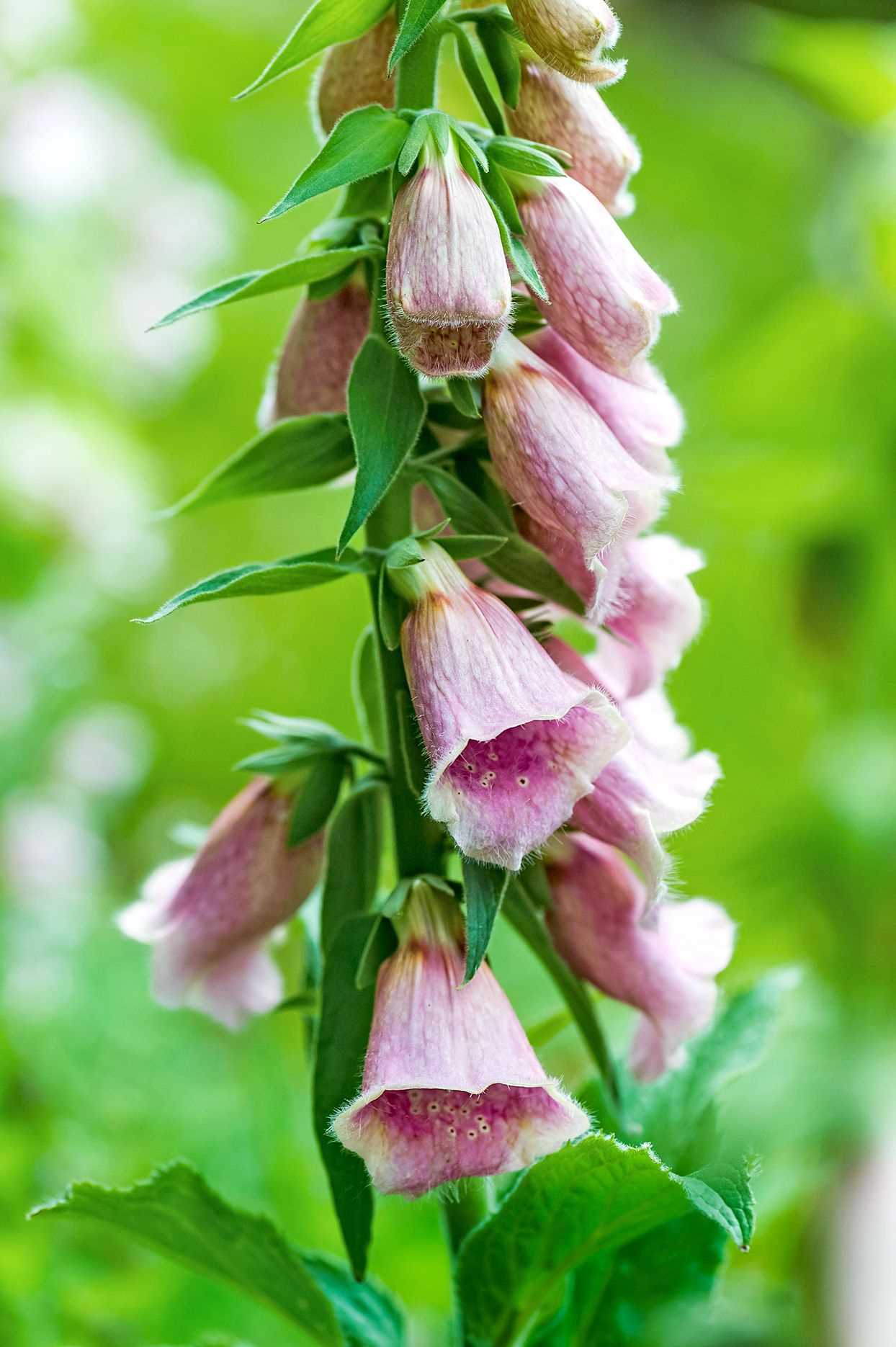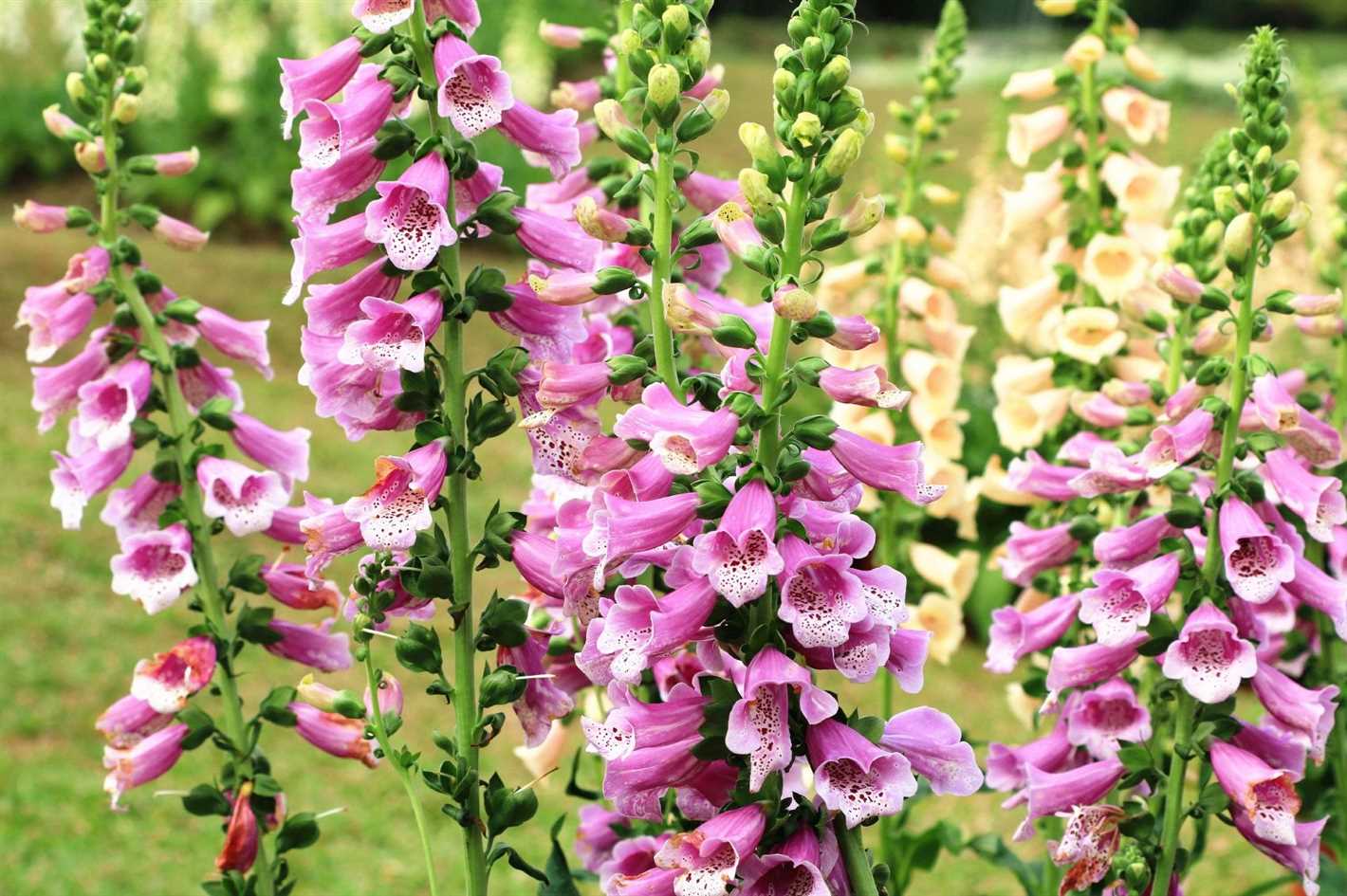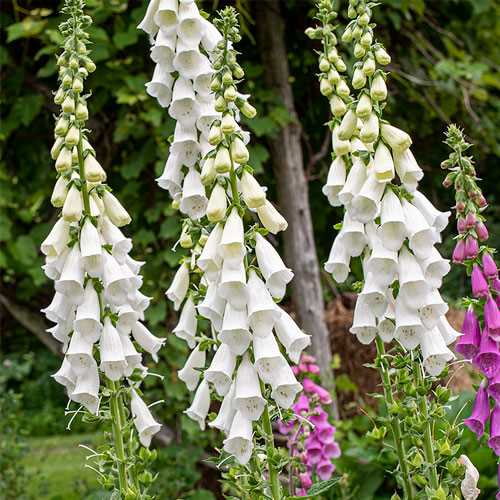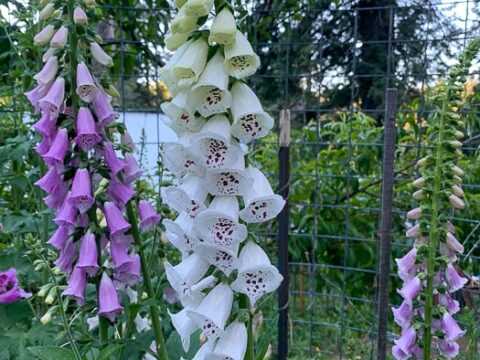- Benefits of Growing Foxglove
- Choosing the Right Type of Foxglove
- 1. Height
- 2. Flower Color
- 3. Type of Growth
- 4. Sun or Shade
- 5. Soil Type
- Foxglove Seeds: When and How to Plant
- When to Plant Foxglove Seeds
- How to Plant Foxglove Seeds
- Conclusion
- Caring for Foxglove Plants
- Watering
- Sunlight
- Soil
- Fertilizer
- Staking
- Deadheading
- Pests and Diseases
- Winter Care
- Additional Tips
- Common Pests and Diseases of Foxglove
- Pests
- Diseases
- Conclusion
- Stunning Varieties of Foxglove
- 1. Digitalis purpurea ‘Dalmatian Purple’
- 2. Digitalis purpurea ‘Foxy’
- 3. Digitalis grandiflora
- 4. Digitalis purpurea ‘Candy Mountain’
- 5. Digitalis purpurea ‘Sutton’s Apricot’
- 6. Digitalis lutea
- Tips for Growing Foxglove Successfully
- 1. Choose the right location:
- 2. Prepare the soil:
- 3. Sow the seeds correctly:
- 4. Transplant with care:
- 5. Provide adequate water:
- 6. Mulch and weed:
- 7. Support tall varieties:
- 8. Deadhead and stake:
- 9. Watch out for pests and diseases:
- 10. Enjoy the blooms and save seeds:
- Questions and Answers:
- How do you grow foxglove from seeds?
- What are the different types of foxglove?
- When is the best time to sow foxglove seeds?
- How long does it take for foxglove seeds to germinate?
- Can foxglove be grown in containers?
- Videos: Foxgloves / Saving & Sowing Seed NOW for next year’s blooms / Homegrown Garden
Foxglove, also known as Digitalis, is a beautiful plant that is native to Europe and Asia. It is known for its tall spikes of tubular flowers that come in a variety of colors, including pink, purple, white, and yellow. Foxglove is a popular choice for gardeners because of its ability to attract bees and butterflies.
If you’re interested in growing foxglove in your own garden, one of the easiest ways to get started is by growing it from seeds. Foxglove seeds are readily available from a variety of sources, such as nurseries and online seed catalogs. With a little patience and care, you can grow your own foxglove plants and enjoy their beautiful blooms.
There are many different types and varieties of foxglove to choose from. Some of the most popular types include the common foxglove (Digitalis purpurea), which is known for its tall spikes of pink or purple flowers. Another popular variety is the yellow foxglove (Digitalis grandiflora), which has bright yellow flowers and is more compact than the common foxglove. There are also many hybrid varieties available, which offer a wider range of colors and flower forms.
When it comes to planting foxglove seeds, it’s important to choose a location that offers partial shade and well-draining soil. Foxglove plants prefer slightly acidic soil, so you may need to amend your soil if it is too alkaline. Once you have prepared your soil, simply sprinkle the seeds on the surface and press them lightly into the soil. Keep the soil moist but not wet, and be patient as it can take several weeks for the seeds to germinate.
Once your foxglove plants have germinated and are a few inches tall, you can transplant them into their permanent growing location. Foxglove plants should be spaced about 1 to 2 feet apart to allow for adequate air circulation. Water your plants regularly, especially during dry periods, and apply a layer of mulch around the base of the plants to help conserve moisture. With proper care, your foxglove plants will bloom from late spring to early summer and provide a stunning focal point in your garden.
In conclusion, growing foxglove from seeds is a rewarding experience that can add beauty and charm to any garden. By choosing the right types and varieties, providing the proper growing conditions, and giving your plants the care they need, you can enjoy the stunning blooms of foxglove for years to come.
Benefits of Growing Foxglove
- Foxglove plants are known for their beautiful and elegant flowers that come in a variety of colors such as white, pink, purple, and yellow. These flowers can add a pop of color to any garden or landscape.
- One of the main benefits of growing foxglove is that it attracts pollinators such as bees and butterflies. These pollinators are essential for the pollination of other plants in your garden, which helps to promote a healthy ecosystem.
- Foxglove plants are also resistant to most pests and diseases, making them a low-maintenance option for gardeners. This means you can enjoy the beauty of these flowers without having to worry too much about pest control.
- In addition to their aesthetic value, foxglove plants have medicinal properties. The leaves of the foxglove plant contain compounds called cardiac glycosides, which are used to treat heart conditions such as congestive heart failure and atrial fibrillation.
- Another benefit of growing foxglove is that they are self-sowing plants, which means that once you have a few plants in your garden, they will produce seeds that will germinate and grow new plants. This makes foxglove a cost-effective option for gardeners.
- Foxglove plants are also deer-resistant, which is an advantage for gardeners who live in areas with high deer populations. By planting foxglove, you can help protect your other plants from being eaten by deer.
- Lastly, growing foxglove can create a cottage garden feel in your landscape. These plants are often associated with English country gardens and can help to create a romantic and whimsical atmosphere in your garden.
Choosing the Right Type of Foxglove
Foxgloves are popular garden plants that come in a variety of types and colors. When choosing the right type of foxglove for your garden, consider the following factors:
1. Height
Foxgloves come in different heights, ranging from short to tall varieties. Shorter varieties are ideal for containers and smaller gardens, while taller varieties can add height and drama to borders and backdrops. Consider the overall height of your garden and choose a foxglove variety that will complement the existing plants.
2. Flower Color
Foxgloves are known for their bell-shaped flowers that come in a variety of colors, including white, pink, purple, and yellow. Consider the overall color scheme of your garden and choose a foxglove variety that will complement or contrast with the existing flower colors.
3. Type of Growth
Foxgloves can have different types of growth, including biennial and perennial varieties. Biennial foxgloves grow leaves in the first year and bloom in the second year, while perennial foxgloves come back year after year. Consider whether you prefer a long-term investment or a shorter-term burst of color in your garden.
4. Sun or Shade
Foxgloves can tolerate a range of light conditions, but most varieties prefer partial shade. Consider the amount of sunlight your garden receives and choose a foxglove variety that will thrive in those conditions.
5. Soil Type
Foxgloves prefer well-draining soil that is rich in organic matter. Consider the type of soil in your garden and choose a foxglove variety that will thrive in those conditions. If you have heavy clay soil, you may need to amend it with compost or other organic matter to improve drainage.
Overall, choosing the right type of foxglove for your garden involves considering the height, flower color, type of growth, sun or shade conditions, and soil type. By selecting the right variety, you can ensure that your foxgloves thrive and add beauty to your garden.
Foxglove Seeds: When and How to Plant
Planting foxglove seeds is a simple process that can be done at the right time and with the right technique. Here are some guidelines on when and how to plant foxglove seeds to ensure successful growth:
When to Plant Foxglove Seeds
Foxglove seeds should be planted in early spring or late summer/early autumn. This timing allows the seeds to germinate and establish before the cold winter months or the scorching heat of summer. It is important to avoid extreme temperatures when planting foxgloves.
How to Plant Foxglove Seeds
Follow these steps to plant foxglove seeds:
- Prepare the soil: Choose a location with well-draining soil that is rich in organic matter. Foxgloves prefer slightly acidic soil. Loosen the soil and remove any weeds or rocks.
- Sow the seeds: Sprinkle the foxglove seeds on top of the prepared soil. Do not cover the seeds with soil, as they require light for germination.
- Water the seeds: Gently water the seeds, ensuring the soil is evenly moist. Avoid overwatering, as it can cause the seeds to rot.
- Provide the right conditions: Place a clear plastic cover or a seed tray with a clear lid over the seeds to create a humid environment for germination. Keep the seeds in a warm location, ideally between 65 and 70 degrees Fahrenheit.
- Monitor and care for the seedlings: Once the seeds have germinated and tiny seedlings appear, remove the plastic cover. Maintain consistent soil moisture by watering when the top inch of soil feels dry. Thin the seedlings to about 12 inches apart to allow for proper growth.
Note: Foxglove seeds can also be started indoors 8-10 weeks before the last expected frost. Transplant the seedlings outdoors when they are 3-4 inches tall.
Conclusion
By planting foxglove seeds at the right time and following the correct technique, you can enjoy the beauty of these elegant flowers in your garden. Remember to provide the right conditions and care for the seedlings to ensure their successful growth.
Caring for Foxglove Plants
Watering
Water foxglove plants regularly, aiming to keep the soil evenly moist. They prefer a slightly moist soil, so avoid letting the soil dry out completely between waterings. However, be careful not to overwater, as this can lead to root rot.
Sunlight
Foxglove plants prefer partial shade or filtered sunlight. They can tolerate some direct sunlight in the morning or late afternoon, but too much can cause the leaves to wilt or burn. If you live in a hot climate, it’s best to provide some shade during the hottest part of the day.
Soil
Use well-draining soil for your foxglove plants. They prefer a slightly acidic soil with a pH between 6.0 and 7.0. If your soil is heavy or clay-like, consider amending it with organic matter, such as compost, to improve drainage.
Fertilizer
Apply a balanced, slow-release fertilizer to your foxglove plants once a month during the growing season. Alternatively, you can use a liquid fertilizer diluted at half strength every two weeks. Be careful not to over-fertilize, as this can lead to leggy growth and fewer flowers.
Staking
Some foxglove varieties can grow quite tall and may require staking to prevent them from toppling over. Use bamboo stakes or other support structures to prop up the plants, tying them together loosely with twine or plant ties. Do this early in the spring before the plants get too tall.
Deadheading
After the flowers fade and begin to wilt, remove them by cutting off the entire flower stalk at the base. This process, known as deadheading, encourages the plant to put its energy into producing new flowers instead of setting seed. It also helps prevent self-seeding, which can be undesirable in some gardens.
Pests and Diseases
Watch out for pests such as aphids, slugs, and snails, which may feed on foxglove plants. Treat infestations promptly with organic or chemical pest control methods. Foxglove plants are generally resistant to most diseases, but they can develop root rot if overwatered or left in waterlogged soil.
Winter Care
In colder climates, foxglove plants may survive the winter if given some protection. Cut back the foliage to about 6 inches above ground level in late fall, and cover the plants with a layer of mulch or straw. This will insulate the plants and help them survive the cold temperatures.
Additional Tips
- Remove any dead or damaged leaves regularly to keep the plants healthy and attractive.
- Watch for signs of wilting, as this may indicate the need for more water.
- Consider dividing the plants every few years to maintain their vigor and prevent overcrowding.
- Be cautious when handling foxglove plants, as all parts of the plant are toxic if ingested.
Common Pests and Diseases of Foxglove
Foxgloves are generally quite hardy plants, but they can still be susceptible to certain pests and diseases. Being aware of these common issues can help you take proactive measures to protect your foxgloves and ensure their health and well-being. Here are some of the most common pests and diseases of foxglove:
Pests
- Aphids: These small, soft-bodied insects feed on the sap of foxglove plants, causing yellowing leaves and stunted growth. They can be controlled by spraying the plants with a strong jet of water or by using insecticidal soap.
- Slugs and Snails: These mollusks can chew on the leaves and stems of foxgloves, leaving behind large holes. To discourage slugs and snails, you can remove any garden debris that they may hide under and create barriers around your foxgloves using copper tape or crushed eggshells.
- Rust Mites: Rust mites are tiny pests that can cause discoloration and distortion of the leaves. Regular monitoring and the use of insecticidal soap or neem oil can help control rust mite infestations.
Diseases
- Powdery Mildew: Powdery mildew is a fungal disease that appears as a white or gray powdery coating on the leaves, stems, and flowers of foxgloves. Good air circulation, proper spacing, and fungicidal sprays can help prevent and control powdery mildew.
- Crown Rot: Crown rot is a fungal disease that affects the base of the foxglove plant, causing the leaves to wilt and the plant to eventually die. Avoid overwatering and ensure proper drainage to prevent crown rot.
- Leaf Spot: Leaf spot is a fungal disease that causes dark spots or lesions on the leaves of foxgloves. It can be controlled by removing and disposing of infected leaves, improving air circulation, and avoiding overhead watering.
Conclusion
By staying vigilant and taking prompt action, you can prevent and manage common pests and diseases of foxgloves. Regularly inspect your plants for any signs of infestation or illness, and take the necessary steps to protect and care for your foxgloves.
Stunning Varieties of Foxglove
Foxgloves are known for their tall spires of bell-shaped flowers that add a touch of elegance to any garden. They come in a variety of colors and sizes, and here are some stunning varieties to consider for your garden:
1. Digitalis purpurea ‘Dalmatian Purple’
This variety of foxglove features deep purple flowers with white throats. It grows up to 2-3 feet tall and blooms in late spring to early summer. ‘Dalmatian Purple’ is a compact variety that is perfect for small gardens or containers.
2. Digitalis purpurea ‘Foxy’
‘Foxy’ foxgloves are a mixture of vibrant colors, including lavender, pink, purple, and white. They reach heights of 2-4 feet and bloom in early to mid-summer. ‘Foxy’ is a popular choice for cut flower arrangements and attracts hummingbirds and butterflies to the garden.
3. Digitalis grandiflora

This foxglove variety produces dense spikes of lemon yellow flowers. It grows up to 3 feet tall and blooms in early summer. ‘Digitalis grandiflora’ is a perennial foxglove that is known for its longevity and ability to attract bees and butterflies.
4. Digitalis purpurea ‘Candy Mountain’
‘Candy Mountain’ foxgloves are a stunning variety with rosy-pink flowers that have speckled throats. They can reach heights of up to 4-5 feet and bloom in late spring to early summer. This variety is ideal for adding vertical interest to the back of borders or woodland gardens.
5. Digitalis purpurea ‘Sutton’s Apricot’
The ‘Sutton’s Apricot’ foxgloves feature lovely apricot-colored flowers with speckled throats. They grow to about 3-4 feet tall and bloom in late spring to early summer. This variety is highly sought after for its unique color and delicate beauty.
6. Digitalis lutea
Digitalis lutea is a species foxglove with creamy yellow flowers that have a more open, bell shape. It grows to about 2-3 feet tall and blooms from late spring to mid-summer. This variety is perfect for naturalizing in cottage gardens or adding a touch of wild beauty to borders.
These stunning varieties of foxgloves will not only add beauty to your garden but also attract beneficial insects and pollinators. Make sure to choose the right variety based on your garden’s growing conditions and desired color palette.
Tips for Growing Foxglove Successfully
1. Choose the right location:

Foxgloves prefer partial shade to full sun. Choose a location that receives morning sun and afternoon shade or dappled sunlight throughout the day. Avoid areas with strong winds, as foxgloves can easily topple over.
2. Prepare the soil:

Foxgloves thrive in well-draining soil that is rich in organic matter. Before planting, amend the soil with compost or aged manure to improve its fertility and drainage. Ensure that the soil pH is slightly acidic to neutral (around 6.0 to 7.0).
3. Sow the seeds correctly:
Start foxglove seeds indoors 8 to 10 weeks before the last frost date. Fill seed trays with a well-draining seed starting mix and scatter the tiny seeds on the surface. Do not cover the seeds with soil, as they require light to germinate. Mist the seeds lightly with water to keep the soil moist.
4. Transplant with care:
When the seedlings have two sets of true leaves, carefully transplant them into individual pots or garden beds. Plant them at the same depth as they were in the seed tray and space them about 12 to 18 inches apart. Handle the seedlings by their leaves to avoid damaging the fragile stems.
5. Provide adequate water:
Keep the soil consistently moist but not waterlogged. Water the plants at the base to prevent the leaves from getting wet, which can lead to disease. Avoid overhead watering, especially in humid climates.
6. Mulch and weed:

Apply a layer of organic mulch around the base of the plants to conserve moisture and suppress weed growth. Keep the area around the plants free from weeds, as they can compete for nutrients and water.
7. Support tall varieties:
If you are growing tall foxglove varieties, install stakes or plant supports when the plants are about a foot tall. This will help prevent them from falling over during strong winds or heavy rain.
8. Deadhead and stake:

Remove spent flowers to encourage continuous blooming and prevent self-seeding. Use stakes or supports to prevent the flowering stalks from bending or breaking under the weight of the flowers.
9. Watch out for pests and diseases:

Keep an eye out for common pests like aphids, slugs, and snails. Use organic pest control methods or insecticidal soap to deter or eliminate pests. Foxgloves can also be susceptible to diseases like powdery mildew and rust, so provide adequate spacing between plants to promote air circulation.
10. Enjoy the blooms and save seeds:
Foxgloves are known for their beautiful tubular flowers that attract bees and hummingbirds. Enjoy the colorful blooms in your garden and consider saving seeds from your favorite varieties for future plantings.
Questions and Answers:
How do you grow foxglove from seeds?
To grow foxglove from seeds, start by sowing the seeds in a tray or pot filled with moist seed compost. Press the seeds lightly into the surface of the compost, as they need light to germinate. Keep the tray or pot in a warm and bright location, and make sure to water regularly to keep the compost moist. Once the seedlings are large enough to handle, transplant them into individual pots and continue to care for them until they are ready to be planted in the garden.
What are the different types of foxglove?
There are several different types of foxglove, including common foxglove (Digitalis purpurea), which is the most well-known variety and has tall spikes of trumpet-shaped flowers in shades of pink, purple, or white. Other types include the Canary Island foxglove (Digitalis canariensis), which has yellow flowers, and the strawberry foxglove (Digitalis mertonensis), which has pink flowers with a white throat.
When is the best time to sow foxglove seeds?
The best time to sow foxglove seeds is in late spring or early summer. This allows the seeds to germinate and the seedlings to grow during the warm months, which will give them a better chance of surviving the winter and flowering the following year. It’s important to sow the seeds at the right time, as foxglove is a biennial plant and needs time to establish itself before it can flower.
How long does it take for foxglove seeds to germinate?
Foxglove seeds usually take around two to three weeks to germinate. However, the germination time can vary depending on the temperature and conditions in which the seeds are kept. It’s important to keep the seeds in a warm and bright location and to keep the compost moist to help speed up germination. If the seeds do not germinate within a few weeks, they may be dormant and may require stratification or scarification to encourage germination.
Can foxglove be grown in containers?
Yes, foxglove can be grown in containers. It’s best to choose a large, deep pot to allow for the long taproot of the plant. Fill the pot with well-draining potting soil and sow the seeds according to the instructions. Place the pot in a sunny location and water regularly to keep the soil moist. Remember to transplant the seedlings into individual pots as they grow and continue to care for them until they are ready to be planted in the garden or kept in the container.







